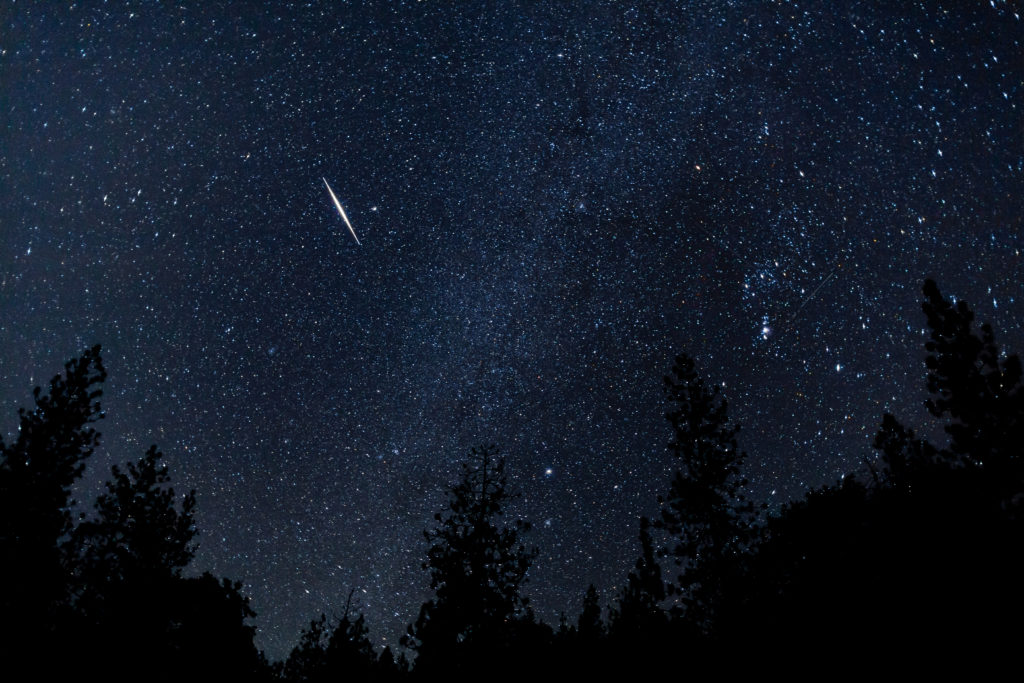Throughout the year, there are different meteor showers that all have different properties and can be more or less easy to spot.
During October, it’s time for the Orionids, one of the best known meteor showers and also the most reliable. This is also an amazing opportunity to venture outside, observe them yourself and find out what makes them so special.
Shooting stars aren’t actually stars, but are caused by meteoroids. These are essentially rocks travelling in space. They can be similar in size to small pebbles and sand or, in rarer cases, bigger objects.
As our Earth moves through its orbit around the Sun, it can run into these objects by chance. There is a lot of this material hitting Earth: approximately 48 tons per day.
As the particles enter our atmosphere, they become meteors. The Orionids have an average speed of about 61 km/s. The interaction with our atmosphere causes them to burn up at high altitude, cause bright streaks in the sky visible for a short time.
Where are they from?
Meteor showers, though, are not random encounters with meteoroids. Earth sometimes passes through denser regions of space debris left behind by comets as they travel around the Sun.
Comets are dirty snowballs made of loose material that is held together by frozen gases. When the Earth encounters comet debris, meteors can streak through the sky, putting on a spectacular display.
WATCH: NASA scientists unveil first near-Earth asteroid sample returned to U.S.
Each meteor shower is linked to a specific comet. The Orionids are of interest, not because there are lots of meteors, but because they are linked to Halley’s comet. This comet was the first to be recognized as periodic – those with orbital periods around the Sun of less than 200 years.
Halley completes an orbit every 75 years. You might have missed it when it was close to us in 1986, but you can still see its trail through the Orionids.
When Halley gets close to the Sun, its ice turns to gas, leaving behind a trail of loose rubble. As Earth passes through this, we encounter the Orionids meteor shower.
Meteor showers are easy to enjoy as no specialist equipment is required. But we must practice patience and hope for good weather. Here are are some tips to ensure your skywatching is successful.
Timing
Make sure to pick the right time. There are at least a dozen meteor showers throughout the year worth catching. They are named after constellations, indicating from which direction the meteors enter our atmosphere.
If you notice the streaks over a night, they will all seemingly radiate from one specific point in the sky (the radiant). For the Orionids that lies in the constellation of Orion, just towards the top left of its shoulder, which is marked by the star Betelgeuse. When you’ve decided on a date, the most promising time of night is usually the second half.
The Orionids peak annually around mid-October. This year’s will be in the hours after midnight on Sunday, Oct. 22, when the highest meteor rates are expected, according to the American Meteor Society.
For the Orionids, you can see an average of 40-70 meteors per hour. If you miss the peak, you will still be able to catch them, you just won’t see as many.
Location
Light is your enemy. Even if the moon isn’t shining, you need to avoid bright lights. Find a spot that is not directly illuminated, but where you feel safe.
You can work with light pollution in general if it is not too extensive. But the darker the sky is, the better the chances of seeing meteors.
WATCH: NASA scientists unveil first near-Earth asteroid sample returned to U.S.
Furthermore, a good view of the sky is required. That does not just mean looking towards the radiant, since meteors will streak across the entire sky.
Make sure you can see as much sky as possible. It might also be worth bringing a deck chair to lie back comfortably.
Patience
To fully appreciate the darkness of the sky and spot even the fainter meteors, you have to ensure your eyes are adjusted to dark conditions. This takes 20 to 30 minutes and cannot be rushed.
Stepping into your garden for a quick glimpse doesn’t work. You should wrap up warm and take something hot to drink with you to keep you going.
Remember that you can spoil your eyes’ adaptation to the dark by switching on a bright white light source. If you need light, cover your flashlight with a red filter. You will be surprised how much you can actually see at night by giving your eyes time to adapt.
The rates that are quoted for meteor showers (40-70 meteors per hour for the Orionids) are averages. They also refer to the darkest possible sky and assume the radiant is exactly above your head.
Sky watching
Meteor watching is an amazing activity for everyone and does not require specialized equipment. It engages you with the universe and requires you to step out of your hectic routine and slow down.
The Orionids are a unique opportunity to connect with the sky. So head out there and explore.
This article is republished from The Conversation under a Creative Commons license. Read the original article.
![]()
